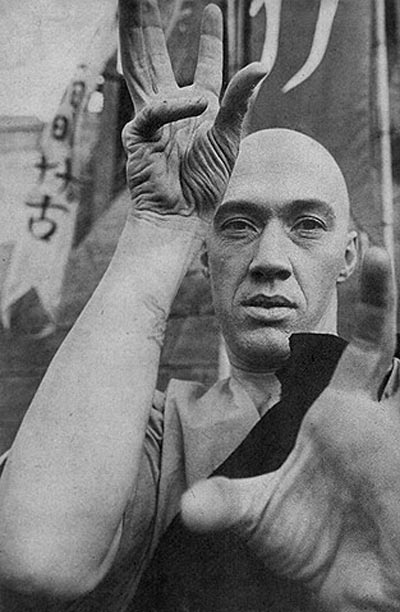
Facsimile Magazine, Published by Haoyan of America. Volume Three, Number Six, 2009. ISSN 1937-2116.
Facsimile June 2009 ~ Wet On Time
Table of Contents

Facsimile Magazine, Published by Haoyan of America. Volume Three, Number Six, 2009. ISSN 1937-2116.
Table of Contents

Frisbee Jackson raises her arms enthusiastically after being honorably discharged. Photo by Haoyan of America
It is with immense pleasure that we announce Frisbee Jackson, a regular contributor to Facsimile, has successfully concluded her four-year stint in the high school. A commitment requiring great fortitude from the very beginning, Jackson had to overcome the well known pitfalls associated with the harsh environment of indiscrimination and banality. Her turbulent career took her from the lows of a misdiagnosed case of intestinal herpes to the highs of evading the NSA while illegally emancipating menial migrant workers from the Mall of America back to their third world countries. All of these misadventures took their physical and mental toll on the young and pheasant Jackson but were not tough enough to deter her from her ultimate goal of receiving an honorable discharge.
She is the only unpaid female Asian American at Facsimile to hold such an honor and is currently hard at work on her undercover investigation of horrific lacerations received from sexual indulgences with heavy machinery. Congratulations Frisbee! We are very proud of you!...
By Melody Morgan

Burt Lancaster in The Swimmer, 1968
And someday there will be a more complete machine. One's thoughts and feelings during life -- or while the machine is recording -- will be like an alphabet with which the image will continue to comprehend all experiences (as we can form all of the words in our language with the letters of the alphabet). Then life will be a repository for death. But even then the image will not be alive; objects that are essentially new will not exist for it. It will know only what it has already thought or felt, or the possible transpositions of those thoughts or feelings. The fact that we cannot understand anything out of time and space may perhaps suggest that our life is not appreciably different from the survival to be obtained by this machine. When minds of greater refinement than Morel's begin to work on the invention, man will select a lonely, pleasant place, will go there with the person he loves most, and will endure in an intimate paradise. A single garden, if the scenes to be eternalized are recorded at different moments, will contain innumerable paradises, and each group of inhabitants, unaware of the others, will move about simultaneously, almost in the same places, without colliding.
-Alfredo Bioy Casares, The invention of Morel, p. 27
To try and represent the social totality of the year 1968 would be an exercise in futility. Often this period is perceived as one of the most fertile in 20th centuries revolutionary praxis. The social ferment was such that John Cheever's timely short story The Swimmer was adapted to the screen by Frank Perry and his wife Eleanor, galvanizing even the pure icon of leisure himself, the Swimmer, into artistic production. The film is essentially the small-scale construction of one man's model utopia. The architectonic vision he engaged was simple: a continuous monument of swimming pools. This linear journey of social alienation was Ned Merill's (the swimmer) perverse zigzag of concomitant progression and regression. A temporal limbo doubling Franco Borsi's reflection on how the increased distance of an imagined date corresponds directly to the strengthening of the utopian pull, "the time sign can even be reversed, shifting from the myth of the progress to the archeology of myths – the Golden Age, the Garden of Eden, the Apocalypse"(p.14).
The power of cinematic imagination cast Burt Lancaster as the aquatic ape, whose naked genius in the role was convincingly able to project a picture more dystopic than utopic in the terms of moralizing fable. What was actually accomplished, in layman's terms, was an architectural description of an image that does not, but might exist. As a counterpart to the real, Lancaster's delusive character was able to collage a fragmentary construction using real world tools. These material tools cast images of deep oneiric symbolism (water), futurist specter (concrete: channeling Corbu), and microcosmic totality (landscape). With the conflation of synthetic and organic desires, the swimmer was able to create a work of art testing the sublime and artificial boundaries of the irrational.
The social moment offered itself as a situation, and the swimming pool as the salacious mise-en-scène. The story takes place in an upper class suburb of Connecticut, although the reel is a testament to the dogged vocation of the location scout who plotted the shoots on a grid of sundry better homes and gardens and finally under the uncanny ambience of studio dayglow spotlights. The narrative begins in the prototypical movement of the utopian form. There is a journey, or more precisely, a voyage to be made. The first sequence of the film is an aerial shot, much like the birds eye view of the architectural plan, in virtual reconnaissance of the terrain. The camera now conspicuously flying through the trees leaps, dives; the swimming pool penetrated. Our confrontation with the utopian construct is immediate. The structure is the swimming pool: artifact and water. The dive the camera takes miming the robust thrust of the swimmer's attuned physique. Thomas van Leeuwen explains, "by diving the swimmer retraces the expulsion from paradise, brought about by birth, in the certainty that his fall will be broken by water. The water of the pool acts as a shock absorber for a gradual reentry into paradise. Once in the water, a state of weightlessness envelops the diver, who becomes swimmer the moment he loses his postnatal anxiety and returns to the womb, where he regains his original state of intense well being. In that sense diving and swimming belong to the same order of existential experience, just as Jonah and the Whale belong to each other: the dangerous journey ends in the ultimate safety of the ʻwhomb.'"(p.16) The atavistic chaos of the dive sets up an interesting dialectic with David Hockney's California series in which the swimming pool is pictured as a meditation of the dynamism latent in the minimalist composition. The time it took perfect the object -Hockney's canvas construction of the pool- is contrasted with the instantaneous expression of the subject, the diver. The Little Splash (1966) and then The Bigger Splash (1967) exquisitely capture this attenuated abstraction of the surface.

This abstraction of linear/historical time is one elemental vector in the imagining of utopia. The hydrophilic-genetic memory activated by the dive gives birth to Ned Merrill. Following through with the dive … the swimmer travels the length of the pool. At this point the Homeric origin of the narrative is revealed as the swimmer postulates his absurdist journey; he will swim home (the most congenital of utopian constructions). The optimism of the dive omits the preclusion of the cyclical expulsion from the Sisyphean waters. As he expounds on his meticulous plan, the clarity of his conviction foments a tactile vision. The mirroring surface of a chlorinated oasis spreads out before him. It is here that we first glimpse waters metaphoric power of memory and forgetfulness.
All characteristics of the Utopian genre are implicitly outlined in the first five minutes of the film. Now that the Swimmer's eternal rebirth has been established it is time to implicate the heterochrony of the swimming pool, which is in fact, in a constant state of evaporation. This flux is an effective displacement of depletion from abundance, moving the artificial aquatic world and thus modern consciousness farther from the evolutionary life death dependence on the seasons. After time has been severed from the material reality of the swimming pool, the other requirement for a utopian suspension is the enclosure of the physical space. It was Utopos himself who after conquering the island of Abraxa and bestowing upon it his own title effectively sealed his creation with a final act of estrangement. The fifteen-mile channel separating the island from the main land was severed at such a simulated speed as to make the utopian abstraction an act of wonder and fear. Inevitably the Swimmer's amnesic succession from the immediate past leaves him shipwrecked on an inverted island in the hung-over detritus of an endless Sunday time warp. Fredrick Jameson asserts, in his meditations on the utopian enclave, "that the very possibility of Utopian space is itself a result of spatial and social differentiation. But it is an aberrant by-product, and its possibility is dependent on the momentary formation of a kind of eddy or self-contained backwater within the general differentiation process and its seemingly irreversible forward momentum. This pocket of stasis within the ferment and rushing forces of social change may be thought of as a kind of enclave within which Utopian fantasy can operate."(15)
The Westerhazy's modern backyard retains the microcosmic dimension of the garden's totalizing form; a vast undeveloped forest of green foliage engulfs the estate and its terraced swimming pool. van Leeuwen traces the relation of the island and the swimming pool:
In a particular yet not illogical way, small idyllic islands have a certain affinity with swimming pools. The Greek word for island–nasos or nesos-derives from neo, to swim; an island is nasos, "he who swims" or rather "she who swims," because nasos is feminine. The discovery of the island as a place of pleasure cannot be attributed to one period in particular. From Homer to Hadrian and Pliny, the island could be regarded as the haunt of a faun, a nymph, or a beautiful sorceress, or equally as a place of agreeable and secure "isolation." In times when the relation between man and nature existed mainly in terms of fear and domination, the island offered a clean, manageable piece of nature that could be possessed, charted, and defended. In romantic interpretations the island became an object of aesthetic contemplation or a secure refuge and a place of social idealism, conveying a feeling of security evoked by Shelley's phrase "the oasis of the island."(p.63)
And so the islands of the portaging Swimmer, the bourgeois east coast swimming pools, come to share the sublime solitude of a Caspar David Freidrich landscape along with the perverse sensualism of department store millionaire Dr. Max Emden's hedonistic botanik created in a mediterranean micro climate on one of Lago Maggiore's Brissago Islands (In the 1920's Emden bought the existing botanical garden, which he proceded to populated with his favourite species – exotic, beautiful women. He converted the island to a theater of soft core pornographic euphoria replete with frisky young girls playing nude in a marble covered Romanesque swimming pool).
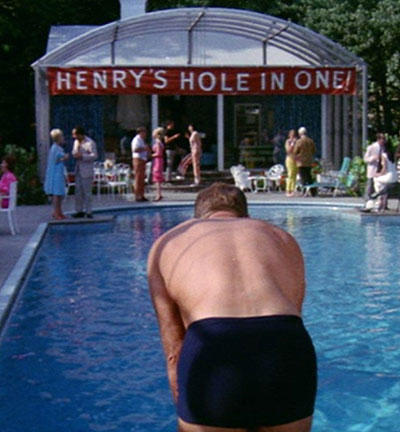
Much like the durations on a Situationist map, Merrill is able to connect the swimming pool of the Westerhazys, to the Biswangers, to the Grahams, to the Hammers, to the Lears, to the Howlands, and the Crosscups, and so on and so forth, a continual composition. His radical mapping of humid, midsummer ambiances into the veritable waterslide of paradise is an accomplishment he perceives - in complicit conferral with Guy Debord's Paris - as a contribution to modern geography. The incipient practice of visualizing the network is readily acknowledged by Michel Foucault in his seminal 1967 lecture Of Other Spaces, "We are at a moment. I believe, when our experience of the world is less that of a life long developing through time than that of a network that connects points and intersects with its own skein. One could perhaps say that certain ideological conflicts animating present day polemics oppose the pious descendents of time and the determined inhabitants of space." And so it is, the swimmer's determinate polemic leaves him forlorn on his forgotten island, cut off from both time and space.
Ned Merrill's consistent use of the term portaging in relation to his imaginary vessel of transportation, his boat, returns reference to the dialectic of Foucault. As attested:
if we think, after all, that the boat is a floating piece of space, a place without a place, that exists by itself, that is closed in on itself and at the same time is given over to the infinity of the sea and that, from port to port, from tack to tack, from brothel to brothel, it goes as far as the colonies in search of the most precious treasures they conceal in their gardens, you will understand why the boat has not only been for our civilization, from the sixteenth century until the present, the great instrument of economic development (I have not been speaking of that today), but has been simultaneously the greatest reserve of the imagination. The ship is the heterotopia par excellence. In civilizations without boats, dreams dry up, espionage takes the place of adventure, and the police take the place of pirates.
The boat is Merrill's refuge, his source of inspiration. Yet his references to boats must also be taken as a hermeneutic outcry foretelling his hydrophobic weariness and his inability to turn back to his port of origin. In one poetic stanza Ned Merrill longingly animates a massive stand of cumulus cloud. It is seen from the distance like a dream city from the bow of the ship "Lisbon, Naples, Istanbul (old world paradise) Hackensack (new world paradise?)." This mordant poetry must be of the same perverse brand of "heroism indissociable from cynicism" that Jameson attributes his scandalous political thinkers. Here is the implication of the Hackensack model, a suburban tautology that stands in as the blueprint for the fundamental social problem.
The saccharine façade of the suburban myth glazes over the ennui of Merill's martini drenched beau monde, like sugar on strawberries. Yet the Swimmer's diet of relentless anomie is what the culinary master of architecture himself, Cedric Price, deemed "sheer confection". "So it is another rule for the whole nature of architecture: it must actually create new appetites, new hungers – not solve new problems; architecture is too slow to solve problems."(p.57)
The American suburb did in fact create new architectural appetites, an escapist heterotopology into which the swimming pool belongs. Frank Perry's, "The Swimmer" is able to catalogue within its structure 11 homeomorphic instances of the swimming pool, appropriately (since Hollywood is indeed responsible for the propagation of the form) a celluloid archive of this multi-dimensional topology. The cinematic structure becomes a quasi eternity, condensing all forms of the swimming pool into a continuous monument, that is itself outside of time/space and exempt from temporal ravages. In the subversive architecture of the late 1960s, the outreach for fixed relations was an attempt to construct an ideal space by linking the representations of extension and thus forging a new model of the world. New hungers made possible the international distribution of Superstudio's controversial design activities. With their Supersurface, and The Continuous Monument the collective sought to visually articulate the network embodied by the earth's surface. It is clear that the continuous monument was a utopian fantasy that was not just floating around in the ether of the Italian avant-garde, but was already enabling monoliths in cinematic construction.
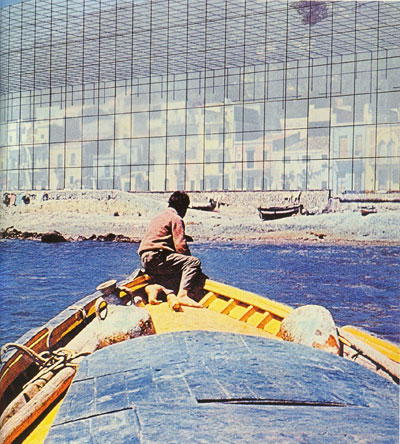
Superstudio
However, unlike the grid or the concept of the Supersurface, the swimming pool is not oriented towards the eternal. The pool is a highly temporal construct of civic miniaturization and privatization, a history coinciding with the beginning of the 20th century. "The compilers of the most recent portfolio, Piscines; equiptments nautiques (1991), deduced, from the fact that the Grande encyclopedie of 1890 still defined piscine exclusively as a development of the Roman thermae and as a liturgical vessel, that the term in the modern sense only came into use in the early twentieth century."(van Leeuwen)
By 1963 there were more than 310,000 swimming pools in the United States, "of which 113,500 are in California. A passenger flying over the Mexican desert can tell when he has crossed the United States border by the swimming pools that suddenly appear below."(qtd in van Leeuwen) In southern California the annual evaporation of swimming pool water alone accounts for the prodigal loss of 15 percent of the valuable drinking water. The ultimate luxury and provenance of utopian fantasy is to turn the world into what it is not. The American sociopath, under the uv potency of southern California radiation has taken the hyperbolic perversion of the elements to the limits, the dry becomes wet and the hot becomes cold. And so the h2o element becomes the calculable replacement of monetary value, equivalent to its absence. The boosters of Los Angeles supplied the nation with their irrational conviction and the Hollywood hucksters produced more than enough seductive images and sensational stories to back it up: the earth's limitless supply of water could not only turn an arid wasteland into a verdant paradise, it could also fill the concrete hole of every upwardly mobile social achiever.
"There was no fracture, no gap between reality and utopia; the real world offered tools capable of crafting the desired world. More's Utopians like their houses so much that they regularly maintained them, thus avoiding the costly and illogical cycle of successive abandonment and restoration of buildings – the idea of "maintenance-refurbishment" belongs to utopia."(Borsi 30) A dialectic that becomes acute in The Swimmer, is that of maintenance. Devices are the hot topic for the repressed bourgeois busy bodies. Housewives apply themselves to the purification of water, and spare no eulogies on their capacious filters. Much of the dialogue that evolves around the periphery of the pool revolves specifically around the subject of its maintenance.
An alphabet derived from instruction manuals and home & garden magazines becomes the new utopian vocabulary. This is the lingua franca of the modern gadget happy inhabitants connecting the fragmented islands, pool by pool, into the Lucinda River. Although we are immediately bombarded by talk of electric toothbrushes and Caribbean cruises, the best early example of this emerging language takes place poolside at the Grahams. Betty and Howard Graham have just installed a freeform organic boomerang shaped pool. The typology highly fashionable in the post war years, resembling a Miro painting or a Calder mobile. Both the Grahams recount the same insipid tale of their extravagances in hygienic maintenance; their diatomaceous earth filter can filter "99.99.99% of all solid matter out of the water. They put a six-inch lint filter in too!" Betty claims, "The way we take care of this pool the water is purer than drinking water."

Inversely the swimmer's alcoholic incontinence feeds into the psychedelic soft focus montage sequences of lens flares and sexualized tangents usually involving bikini clad nubiles that detour the drift from pool to pool. These variant flourishes and stylistic distractions are symptoms of the terminal gestalt of 60s counterculture and entertain about as well as the grateful dead during marijuana withdrawal. To be appreciated at all, these transgressions must function as an allusion to the utopian/distopian binary that always besieges best intentions.

The typologies of the 11 diverse swimming pools are able to contribute more than aesthetic superlative to the cinematic adaptation of the short story. Frank Perry was able to use the various styles of the profligate status symbol as a meditation on the identity of his suburbanites. The rich subtext proffered by the unique shapes of the pools adds an illustrative depth to the characters. Speaking of the semiotic complexity the swimming pool added to the system of domestic architecture Thomas van Leeuwen explains, "In the shortest possible time radical associationism ran rampant. Just as, in the ice cream business, existing flavors were quickly exhausted and new composite ones had to be invented, similarly every owner, through his residence, pool or garden, could send off his own message of poetic license. Although historians are accustomed to classify houses by their stylistic appearance, such a system loses its clarifying purpose when it comes to contain–as with varieties of ice cream–as many denominations as there are items". Instead of using houses, cars, pets, and lovers as signifiers, Perry must focus on the expression of one common denominator as the indexical leitmotif to his narrative: the absurd folly of the swimming pool.
The most complex of all the swimming pools is the ceramic tile post-modern monster commissioned by the Biswangers. It resembles the floor plan of a Roman Basilica yet is enclosed by 30,000 lbs of structural aluminum and clear plastic in the streamlined form of an air hangar. It is the decorated shed. The crystalline reflection metamorphoses the pool into a selfreflexive tension between space and surface. The image of the architecture and its inhabitants plays upon the mirroring powers of the swimming pools surface, hyperbolizing the dynamism that erodes the architectural forms inherent, or at least perceived, permanence. Joan Rivers and Burt Lancaster find each other in the raucous crowd, Joan says, "boy, you sure gotta like to swim if you go in on this expenditure." No one is in the pool, no one is even dressed to swim.
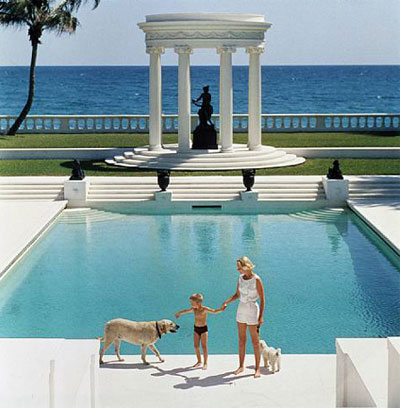
Nice Pool by Slim Aarons, 1955
The architectural part of the swimming pool - the artifact - is from the outset easy to define, whereas its contents - the natural part - are highly complex. The formal imagining of a textual utopia could never have been born without the materials of the physical world. It is the material imagination of water that opens the Utopian dimension of the swimming pool. Water is the powerful force enabling the swimming pool to be both status symbol and oneiric device - to be utopian idea, object, space and image - automatically absorbing the realms of mythology and depths of psychology. Water, or the reflected image, is the dream or the imagination of matter itself. When in a horizontal arrangement, water's mirroring mechanism begins to function at a level of oneiric profundity that escapes the object mirror. Foucault discusses at length the theoretical importance of the mirror as a wormhole utopia, "The mirror is, after all, a utopia, since it is a placeless place. In the mirror, I see myself there where I am not, in an unreal, virtual space that opens up behind the surface; I am over there, there where I am not, a sort of shadow that gives my own visibility to myself, that enables me to see myself there where I am absent: such is the utopia of the mirror." Water does wonders to naturalize the idea of utopia and to actually accommodate a physical place (or non-place) in the world for utopia to exist.
The renowned Baroque garden at Chantilly, designed by Le Notre who was commissioned by the rebel Prince de Conde, presaged the modern swimming pool by more than two hundred years. The pools at Chantilly are without the intervention of sculpture and the artifice of fountains. "At Chantilly it is the natural reflective quality of the pools-creating fragmented, anamorphic visions on their uneven undulating surfaces- that constitutes that garden's dominant spectacle, where a distorted yet ever beautified version of nature is created." (Weiss, p.83-84) The visceral surfaces of the pools at Chantilly can be perceived as the perfect metaphor for the easy obfuscation of any utopian construction. Crafted with the tools of reality but always immediately severed from the real, no Utopia ever succeeds. No utopia can maintain itself. Gerard Genette writes:
As calm, as dormant as it may be, the water's surface feels the fall of a flower, the passage of a bird, the agitations of the breeze: it undulates even when stagnant, and the image of narcissus undulates with it, animating his forms in an objectless mimicry, distending them, contracting them, bringing to light a disquieting plasticity. However, this image remains an image, and its mobile freedom can be more revealing than the frozen immortality of the mirror. But once again the agitation is accentuated, and the undulation becomes a flickering, splitting up, or dispersion; the continual elasticity of the wave is decomposed into an infinity of juxtaposed facets, in which narcissus disappears in a deceptive intermittence (qtd. In Weiss, p.86).
This Baroque sensibility that Genette writes of is the same warped sensibility (agitation, undulation, flickering, splitting up) that shaped the psychedelic suburban voyage of Ned Merrill.

The Swimmer in its scope becomes the magnum opus of the 2oth Century dystopia by successfully arranging all the historical conditions necessary for an ideal world and then crushing these naïve illusions by revealing that only their inverse is true. The story represents all the characteristics Franco Borsi deems necessary in transforming utopia to dystopia: isolation and self sufficiency (existential crisis), perfected institutions (post-war America), the abolition /marginalization of the family as societal nucleus (the decay and disappearance of Merrill's own family), obsessive spatial uniformity (suburbs), omnipotent propaganda to insure standardized beliefs (technophilia and leisure).
In the end, the swimmer discovers the empty pool where his lessons in make believe was not enough to stop the eros of a juvenile man from being corrupted by the thanatos of a jaded boy. And finally into the communal pool where regulated leisure completes the regression of the Utopian genre all the way back to the penance of More. Shivering in his speedo as the summer sun gives way to the blithe setting of the winter sky, the bare ash tree has lost its leaves, and Ned Merrill embarks on the last leg of his voyage. Now a quadruped on all fours, he hobbles up the faux granite incline to his house atop the hill. The deluge of a winter storm transforms his tennis count into a ruinous swimming hole. His family is gone, the house in decaying ruin, a paradiso perduto, is empty. Here the words of Gaston Bachelard become a more sonorous substitute for the gesticulating soundtrack:
One cannot bathe twice in the same river because already, in his innermost recesses, the human being shares the destiny of the flowing water. Water is truly the transitory element. It is the essential, ontological metamorphosis between fire and earth. A being dedicated to water is a being in flux. He dies every minute; something of his substance is constantly falling away. Daily death is not fire's exuberant form of death, piercing the heavens with its arrows; daily death is the death of water. Water always flows, always falls, always ends in horizontal death. In innumerable examples, we shall see for the materializing imagination, death associated with water is more dream-like than death associated with earth: the pain of water is infinite. (6)
The utopia of The Swimmer is a construction that manages to separate the space of leisure from the spaces of everyday reality and distend the fragmented surface into a consummatory monument. In the tragic completion of the cinematic narrative we find the infinite wake for utopia in its flux towards its dystopic antonym. Like the cyclical nature of water, this transitory flux characterizes the unremitting journey and the inability to arrive at the no-place of utopia.

In the onslaught of 70s irony the concrete ruin of the swimming pool became the inverted island grotto of the emergent so-cal skateboard culture. It was not until the deadly water was drained that the artifact arrived at its most active form. Defined and re-defined by a more or less explicit utopian impulse; the century of thematic variations ended in the ultimate hydrophobic appropriation of the American swimming pool as a skatepark. As skatepark, the hollow void provided an intra-arterial paradise for the discontented youths of Southern California's Endless Summer, who still radiate the power of their enclave status.
By Tie Liu, from China Herald

Great Firewall of China
comparitech.com/privacy-security-tools/blockedinchina/
In June of 2007, three editors from the Chengdu Evening News were fired after a 13 word ad was published honoring mothers of those who died in the Tianamen Square Massacre. In an ironic testament to the effectiveness of China's state sponsored censorship, the tribute had been allowed to be printed because a clerk at the newspaper was unaware of the events of June 4, 1989.
I am a veteran worker at Chengdu Evening News and therefore I have the right to comment on the matter in which "a thirteen word advertisement that is the size of a cigarette" appeared on the bottom right corner of page 14 of Chengdu Evening News on June 4th.
My purpose is to let the readers and those who care about this affair to recognize the truth and not propagate untruths and rumors. For this purpose, it is necessary first to understand the business and operational models of mainland Chinese newspapers as well as the facts in this particular case.
There are three types of newspapers in mainland China today. First, there are the party newspapers and publications that are subsidized by the party, including
Second, there are the publications which are not subsidized by the state but their principal workers are appointed by the party organization. Most of the other workers are hired through labor contracts that pay very good wages. But the workers do not have the status of government public servants. The state does not offer any subsidies to these publications. On the contrary, at the end of each year, each publication has to turn in a fixed profit revenue to the state (either the supervisory department or the newspaper group to which the newspaper belongs). All the evening newspapers in the cities are like that. Chengdu Evening News belongs to the Chengdu Newspaper Group, which is directly managed by the Chengdu city government's publicity department.
Third, there are the departmental and industrial newspapers. The state does not provide any funding and they are not included in the organizational system. These departments and industries are often too poor to operate a newspaper, so the newspaper is usually "out-sourced" by renting out the publication permit although the contents have to be reviewed in order to manage the political direction. At present, an official periodical charges only about 500,000 to 800,000 yuan per year from the outsourced supplier. So these are not considered mainstream media and they are not considered to be significant players.
Before 2000, Chengdu Evening News was a party organ for the Chengdu City party committee. The chief editor was a member of the city party committee. Following the reform of the newspaper system and the establishment of the newspaper group, the Chengdu City party committee restored the original Chengdu Daily News and built the Chengdu Newspaper Group around it, which incorporated the Chengdu Commercial News that was garnering 200 to 300 million yuan in annual advertisement revenues from government and businesses. It also demoted Chengdu Evening News to an urban economic newspaper inside the group. So even though Chengdu Daily News was losing money, the Chengdu Newspaper Group had two other economic powerhouses that made it into a formidable newspaper group that is engaged in multiple businesses. While the calls for "separation of party and government" and "separation of politics and economics" have been going for many years, they cannot be separated in practice.
Now that we understand the operational system for newspapers in mainland China, let us now talk about the incident of the "thirteen word advertisement that appeared in the bottom right of page 14." Ten years ago, the Chinese periodicals were establishing their own advertising agencies in order to generate revenue. The existing advertising agencies within the system were often ineffective, so they out-sourced their advertising pages to various small and large advertising agencies that have broad social presence. In legalese, these are known as "business representatives."
Chengdu Evening News picks up about 100 million yuan in advertising revenue each year. It has sold its advertising pages to various advertising agencies that are licensed to operate. The present problem occurred with the advertising agency and not with the Chengdu Evening News editorial staff. The advertising agency usually typesets the advertisements and submits the page to the advertising department of Chengdu Evening News. The advertising department composes the page and sends it to printing plant. Before publication, the page editor signs off and the chief editor on duty also gives the final approval.
But we can all imagine how likely that a chief editor or a page editor could be looking at "a thirteen word advertisement that is the size of a cigarette" in the context of a newspaper that has thirty-two pages each day (sometimes expanded to 48 pages).
According to my information, as soon as this advertisement appeared, someone reported to the relevant Beijing authorities immediately. The event was also reported in the overseas websites. That shocked the provincial and city government leaders and they immediately dispatched people to Chengdu Evening News to investigate. On that evening, executive chief editor Li Xiaojun, the page editor and the advertising manager were all suspended from their jobs temporarily. Mister Li Xiaojun joined the newspapers as an intern in 1980. I met him when I worked at the newspaper. He was sincere and professional. After more than twenty years, he arose from an intern to the executive deputy chief editor position, and that is not easy! It is uncertain whether he will be able to keep his job. That person who bought the advertisement has not been located by the public security department as yet.
From the process how the whole affair unfolded, this was a planned "prank." This "prank" reflected the public opinion of the Chinese people in terms of its deep sympathy for the victims of June 4th and respect for the mothers who lost children. The most thorough way to resolve this problem is for the Chinese authorities to recognize history and look it squarely. They should "vindicate" the victims of June 4th and not to assign political responsibility for "a thirteen word advertisement that is the size of a cigarette." If they want an investigation, they should investigate who were the butchers who suppressed the students! They cannot invert the priorities and create new incidents. As a veteran of Chengdu Evening News, I call for the authorities to restore the jobs of Li Xiaojun and others. Furthermore, they should not go after the principal who started this incident. To use a common saying in China: "A pile of feces sitting there does not stink much unless you stir it up."
It is so sad for China. The Chinese Communist are so vulnerable that they are afraid of "a thirteen word advertisement that is the size of a cigarette." They are even more afraid of the voices of old people like us trying to commemorate the fiftieth anniversary of the Anti-Rightist Campaign. Can a history written in blood be purged and forgotten? The people in charge of compiling dictionaries have a huge problem. Six cannot be placed next to four, rightists cannot be mentioned and the Cultural Revolution cannot be reported. If all the disasters in history are not allowed to be mentioned, then can this still be called a nation? The value of history is that it can be handed down, which meant that memory is essential. Presently, the Chinese authorities are most afraid that the people should have memories. What can this idiotic action possibly achieve? This is the most fantastic of fantasies! Here I can use the two lines of poetry from Liu Yuxi.
A thousand sails go past the sunken boat,
A thousand trees bloom in front of the ailing tree.
Spring will come eventually.
By Frisbee Jackson

The Deer, Photo by Hannanik
The oyster-shell sheen of the gasoline film dissipated as soon as her thin tire cut through the puddles. The raincoat flapped against her torso - a fish struggling out of the net, as the displaced water splashed her legs. The dirty water left brown splotches on her calves. But it was no bother. She kept pedaling, harder harder harder, her silvery reflection on the slick paved roads loyally following. There was the faint sound of a train in the distance.
Only a single thought pressed in her mind: get there. Fast. It would be gone soon, and then another opportunity lost. The train only came to town once every two years - chugging through, on the rare day the main station was down for repairs. Every two years, on the dot, there would be a day when the main terminal would need a little fixing or new paint job. Even when there wasn't anything to do, the proprietors, accustomed to taking that day off, would find an excuse to close it down. The detour took the train right onto the outskirts of her town. And every 2 years, since she was a little girl, she'd come down to see the train when it chugged by. It wasn't often such an industrial spectacle made its way through town, so it wasn't uncommon for the train to draw a small crowd of observers on a nice day. This time, however, it'd probably just be her - the rain continued with persistence.
The train horn sounded again -it was closer this time. Faster faster faster. Almost there. Her heart rate was at a steady peak. She needed to get there―this year especially. She needed something to remind her friend of home. He had been away and was terribly homesick. She knew just the thing to send him that would cheer him up.
By the time she reached the tracks, she could see the train above the horizon; it was a few hundred feet away. She quickly untied her draw-string pouch and grabbed a few tiny shiny copper discs and placed them on the track. This should do the trick.
By Leonard Koren, excerpts from 13 Books: (Notes On The Design, Construction & Marketing Of My Last...)

Feburary/March 1977 issue of WET magazine
WET was an avant-garde Los Angeles-based magazine founded by Leonard Koren that helped define LA's New Wave scene while revolving around the idea of "gourmet bathing and beyond." The publication covered cultural issues and was known for its innovative use of graphic art.
Contributors included Kristine McKenna, Mark Mack, David Lee Roth, Leonard Cohen, and Matt Groening. WET lasted 34 issues spanning from 1976 until 1981.
Subject Matter
Initially, any aspect of bathing, however tenuous. After the first year of publication, the subject matter extended to "gourmet bathing" in a metaphorical sense: an eclectic lifestyle grounded in a boundless appreciation of absurdity.
An appreciation of absurdity spawned such quintessential WET articles as "Sex with the Dead: Art or Atrocity?" by staff editor Lewis MacAdams. MacAdams reports how John Duncan, a Los Angeles-based performance artist, travels to Tijuana, performs sex with a corpse, then has a vasectomy. When Duncan returns to L.A. he stages a performance piece about these experiences. The audience, a group of Duncan's peers, becomes enraged and excommunicates him from the performance art community. MacAdam's piece raises questions about art-world politics, the nature of taboo, morality, tragedy, voyeurism, and, of course, the bizarre and perverse.
My bath artist phase lasted for about a year and a half. It resulted in artworks such as "Cleanliness Is Next to Impossible" (an edition of offset lithographic prints), "Mudbath" (an edition of hand-painted offset lithographic prints), "Pagan Baptism" (a series of large, penciled-over photographs), and "Better Wetter" (a collection of one-of-a-kind vinyl shower curtains).

Inspiration
During my bath artist phase, I held a party at an old Russian-Jewish bathhouse to thank the models - mostly friends and acquaintances - who posed for both 17 Beautiful Men Taking a Shower and its companion piece, "23 Beautiful Women Taking a Bath" (a silkscreen print). The party was a tremendous success. I felt compelled to figure out a way to harness the reservoir of social energy I had inadvertently tapped into. While bathing one afternoon I had an epiphany: why not start a magazine about gourmet bathing?
Models received free admission. Others - art collectors and sundry creative types - paid enough to cover all the party expenses. Of the 150 people who attended, some were attired in suits and ties, others in swimsuits and towels, many in nothing at all. Part of the evening's magic was the spontaneous invention of new social rules in response to the novel environment and confounded expectations; everyone was somehow equally vulnerable and open.
"23 Beautiful Women Taking a Bath" was the piece I wanted to do prior to 17 Beautiful Men taking a Shower. But Stanely Grinstein, the art collector who gave me the money to produce 17 Beautiful Men..., suggested that the less obvious artwork for a heterosexual male - and hence the more interesting - was the one with the men. I heeded Stanley's advice.

Organizing Principles
An eclectic collage; virtually any visual or written piece can be given a WET slant. The pictorial and graphical is more important than the textual. (Legibility and readability are of minor concern.) The design conventions of the magazine changed with every issue. And the format - page size and paper quality - changed seven times during WET's 34-issue lifespan.
Gourmet bathing had little meaning other than the conjoining of two sublimely incongruous words. This semantic frisson heralded WET's essential ambiguity.
A chronic shortage of money, on the constructive side, forced me to learn to operate on a minuscule budget and to cultivate a knack for resourcefulness. (WET's operating bywords were "cheap is good.") This financial discipline set the frugal and self-sufficient tone for all my future projects.
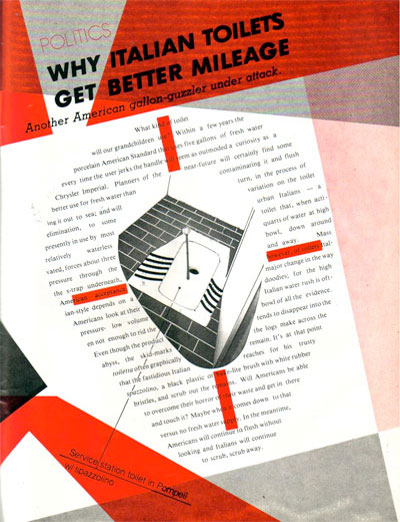
Greatest Difficulties
(1) A chronic shortage of money meant constantly borrowing funds from one person in order to pay back another. (2) I neither liked, nor was good at, managing other people (WET, at its most bloated, had 12 paid employees).
Investors included Lyle Mayer (WET's associate publisher and a childhood friend) and Laura and Fred Clarke, a couple I had met while attending architecture school (she was a fellow student, he was already in practice). Then came Guy Webster, a commercial photographer (the older brother of a friend). And finally, four years into publishing the magazine, there was Max Palevsky, a retired computer industrialist (I made dozens of cold calls to rich folks who fit a potential profile I had concocted; Max was the first one who bit). All the investors contributed much more than merely money. Guy, for example, continually opened his homes for WET parties, was always available to take photos, and introduce the magazine to his high-profile show business friends who, in turn, boosted WET's cachet in the eyes of potential advertisers.
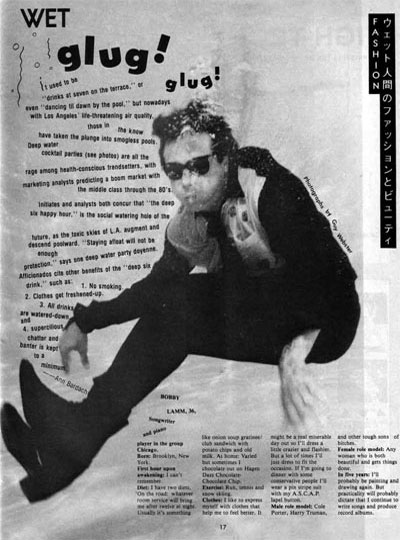
(From July/Aug 1981 Issue)
Dear WET,
I read with sadness and some surprise your "Sex with the Dead" article in March/April 1981 WET. In 1976, I had access to a morgue and did a piece called Necrophilia.
Perhaps John Duncan would not have had to put himself through the mental agony, had he seen that I had done the piece several years before.
The necrophilia piece came to me after having a dream that I was fucking a seductive and beautiful living woman who rapidly aged and died as we were making love. She clamped her arms around me and the sides of the bed became a coffin enclosure.
The dream was terrifying but I saw the Necrophilia piece as the ultimate resolution of polarities - Life/Death - if you could love death you could accept and love life more fully.
After doing the morgue pieces I felt less afraid of death, but more afraid of the moral and karmic consequences of my actions. I was heavy into LSD at the time and had a few revelations about our immortality. In 1979 I hallucinated a trial of the souls who were involved. I met the soul of the woman that I had sex with. She was extremely angry and screamed at me saying - didn't I know I was violating her and that she was a person just as I was. I was so sorry, disgraced and disgusted with myself, I cried and begged her forgiveness. She did not forgive me, but I was put on a kind of probation by the judge and told to do good works, not harmful and negative works. A day has not gone by that I haven't thought of the necrophilia piece. I guess, during the past couple of years, I have come to regard the body as a sacred thing as well as a piece of meat.
Alex Grey
Boston
(From July/Aug 1981 Issue)
Dear WET,
You are certainly entitled to freedom of the press (in spite of your "enlightening" article on necrophilia and candid photos of young boys jacking each other off). And we are certainly entitled to not renew our subscriptions. Who gives a fuck about the "avant-garde" anyway.
Cindi Galindo
Austin, Texas
(From Nov/Dec 1981 Issue)
Dear WET,
I am a young American. Being such, I am quite accustomed to such events as the mass murders of black children in the south, aerial spraying of unknown poisons over the foods I eat. and even Ronald Raygun being elected president! But when I read in WET that Henry Miller's bathroom was destroyed by the people who bought his home, I was utterly appalled at such a savage atrocity and for the first time in years felt something. I felt a sadness and shame that I did not think still resided within my being. How could it happen? Who the hell allowed such devastation to take place? Won't you please tell me that it didn't happen? With love to Henry Miller who taught me to be a "Gangster of Love".
Laurie S. Lessen
Larkspur, CA
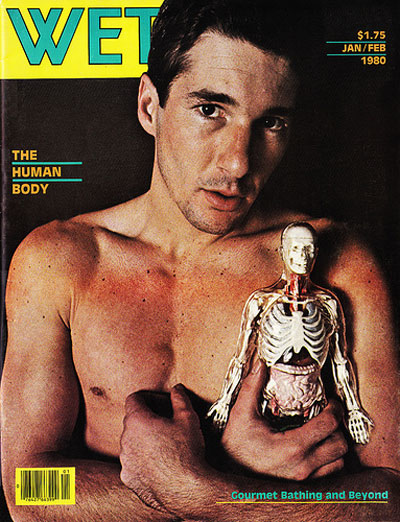
From The Mayor of Castro Street by Randy Shilts

Harvey Milk
Haunted for years by forebodings that he would fall victim to political assassination, Harvey Milk recorded three tapes to serve as his political will. One was left with his personal attorney John Wahl, one with his close friend Frank Robinson, and another with his friend and political associate, Walter Caplan. Milk spoke only from a bare-bones outline when he recorded the tapes, so all three have variations in specifics. Only Frank Robinson's tapes has the passage which was widely quoted after Milk's assassination: "If a bullet should enter my brain, let that bullet destroy every closet door." Only Walter Caplan's tape is a fifth name, that of former SIR President Doug DeYoung, added to the so-called enemies list of people Milk considered unsuitable to succeed him. Those who have heard all three tapes generally consider Caplan's to be the best-worded of the testaments. This is a complete transcript of that tape.
This is Harvey Milk speaking on Friday November 18. This is tape two. This is to be played in the event of my death by assassination. I've given long and considerable thought to this, not just since the election. I've been thinking about this for some time prior to the election and certainly over the years. I fully realize that a person who stands for what I stand for - a gay activist - becomes the target or potential target for a person who is insecure, terrified, afraid or very disturbed themselves. Knowing that I could be assassinated at any moment or any time, I feel it's important that some people should understand my thoughts. So the following are my thoughts, my wishes, my desires, whatever. I'd like to pass them on and played for the appropriate people. The first and most obvious concern is that if I was to be shot and killed, the mayor has the power, George Moscone's, of appointing my successor to the Board of Supervisors. I know there will be great pressures on him from various factions, so I'd like to let him know what my thoughts are.
I stood for more than just a candidate. I think there was a strong differential between somebody like Rick Stokes and myself. I have never considered myself a candidate. I have always considered myself part of a movement, part of a candidacy. I've considered the movement the candidate. I think there's a delineation between those who use the movement and those who are part of the movement. I think I was always part of the movement. And I think that. I wish I had time to explain almost everything I did. Almost everything that was done was done with an eye on the gay movement.
I would suggest and urge and hope that the mayor would understand that distinction and that he would appoint somebody to my position who also came from the movement rather than used the movement or never understood the movement. I think those people who actively oppose me - the Jim Fosters, Rick Stokes, Jo Dalys, Doug DeYoungs - those people never understood the movement. I'm not saying they're against it. They just never understood it. They used it. Maybe willingly, maybe unwillingly, but they never understood what it was about. I think those who remained in silence - the Frank Fitches, not wishing to play sides - never understood the movement, that silence is sometimes worse than speaking out. I would hope that the mayor would understand that appointing somebody who actively opposed me or subtly opposed me or kept quiet, stuck their head in the sand, would be an insult to everything I stood for, would be an affront to the campaigns and the people who worked.
The first person I would have is a gentlemen by the name os Frank Robinson who is quite an author in his own right. Frank even more so knows my thought processes. Not only has he read everything I've written and helped re-write the major pieces, but Frank is the who who almost daily we had conversations on various points of thinking and philosophies. So he knows my thoughts well. He understands how I arrived at the decisions and he played the devil's advocate time and time again. So if there's anyone who knows me from the depth of the intellect and the emotions, it's Frank Robinson and I think being who he is, he has that incredible ability to express himself clearly and concisely and if there were any problems, he would be able to carry on the philosophy and idea of what I stood for.
If there's some reason Frank is not the choice, the next consideration I would hope the mayor would give would be to Bob Ross. Bob have the guts to speak out in the name of Judaism or Christianity or whatever they profess to be for in words but not actions and deeds. God - and that's the irony. God - churches don't even know what it's about. I would turn over in my grave if there was any kind of religious ceremony. And it's not a disbelief in God - it's a disbelief and disgust of what most churches are about. How may leaders got up in their pulpits and went to Miami and said, "Anita, you're playing gymnastics with the Bible - you're desecrating the bible?" How many of them said it? How many of them hid and walked away? Ducked their heads in the name of Christianity and talked about love and brotherhood.
No services whatsoever. If anything, play that tape of Briggs and I, which is somewhere in the cabinet in the back - the file cabinet. Just play that tape of Briggs and I over and over again so people can know what en evil man he is. So people know what our Hitler is like. So people know that where the ideas of hate come from. So they know what the future will bring if they're not careful.
And that's all I ask. That's all. I ask for the movement to continue, for the movement to grow because last week, I got a phone call from Altoona, Pennsylvania and my election gave somebody else, one more person, hope. And after all it's what this is all about. It's not about personal gain, not about ego, not about power - it's about giving those young people out there in Altoona, Pennsylvania's hope. You gotta give them hope.
By Malaclypse The Younger, from Principia Discordia Or How I Found Goddess And What I Did To Her When I Found Her

Touched by His Noodly Appendage by Niklas Jansson
Grasshopper always Wrong in argument with chicken.
- Book of Chan
Before he became a hermit, Zarathud was a young Priest, and took great delight in making fools of his opponents in front of his followers.
One day Zarathud took his students to a pleasant pasture and there he confronted The Sacred Chao while She was contentedly grazing.
"Tell me, you dump beast," demanded the Priest in his commanding voice, "Why don't you do something worthwhile. What is your Purpose in Life, anyway?"
Munching the tasty grass, The Sacred Chao replied "MU*".
Upon hearing this, absoloutly nobody was enlightened. Primarily because nobody could understand Chinese.
* "MU" is the Chinese Ideogram for NO-THING.
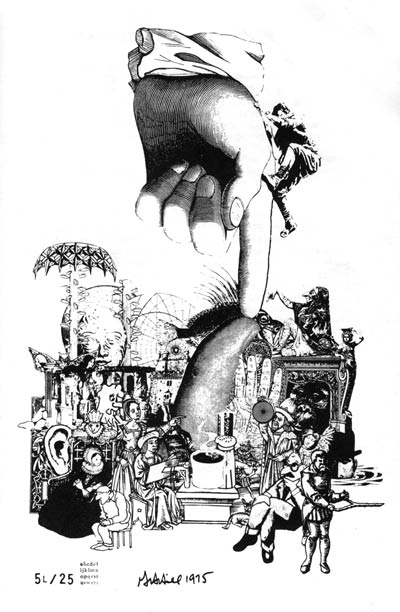
THE SACRED CHAO is the key to illumination. Devised by the Apostle Hung Mung in ancient China, it was modified and popularized by the Taoists and is sometimes called the YIN-YANG. The Sacred Chao is not the Yin-Yang of the Taoists. It is the HODGE-PODGE of the Erisians. And, instead of a Podge spot on the Hodge side, it has a PENTAGON which symbolizes the ANERISTIC PRINCIPLE, and instead of a Hodge spot on the Podge side, it depicts the GOLDEN APPLE OF DISCORDIA to symbolize the ERISTIC PRINCIPLE (both discussed in the Psycho-Metaphysics which we suggest you skip over).
The Sacred Chao symbolizes absolutely everything anyone need ever know about absolutely anything, and more! It even symbolizes everything not worth knowing, depicted by the empty space surrounding the Hodge-Podge.
HERE FOLLOWS SOME PSYCHO-METAPHYSICS. If you are not hot for philosophy, best just to skip it.
The Aneristic Principle is that of Apparent Order; the Eristic Principle is that of Apparent Disorder. Both order and disorder are man made concepts and are artificial divisions of Pure Chaos, which is a level deeper than is the level of distinction making.
With our concept making apparatus called "mind'' we look at reality through the ideas-about-reality which our cultures give us. The ideas-about-reality are mistakenly labeled "reality'' and unenlightened people are forever perplexed by the fact that other people, especially other cultures, see "reality'' differently. It is only the ideas-about-reality which differ. Real (capital-T True) reality is a level deeper than is the level of concept.
We look at the world through windows on which have been drawn grids (concepts). Different philosophies use different grids. A culture is a group of people with rather similar grids. Through a window we view chaos, and relate it to the points on our grid, and thereby understand it. The Order is in the Grid. That is the Aneristic Principle.
Western philosophy is traditionally concerned with contrasting one grid with another grid, and amending grids in hopes of finding a perfect one that will account for all reality and will, hence, (say unenlightened westerners) be True. This is illusory; it is what we Erisians call the Aneristic Illusion (Aneristic DE-lusions, or anerisms, are discussed in the document on Eristic Avatars, elsewhere). Some grids can be more useful than others, some more beautiful than others, some more pleasant than others, etc., but none can be more True than any other.
Disorder is simply unrelated information viewed through some particular grid. But, like "relation'', no-relation is a concept. Male, like female, is an idea about sex. To say that male-ness is "absence of female-ness", or vice versa, is a matter of definition and metaphysically arbitrary. The artificial concept of no-relation is the Eristic Principle.
The belief that "order is true" and disorder is false or somehow wrong, is the Aneristic Illusion. To say the same of disorder, is the Eristic Illusion. The point is that (little-t) truth is a matter of definition relative to the grid one is using at the moment, and that (capital-T) Truth, metaphysical reality, is irrelevant to grids entirely. Pick a grid, and through it some chaos appears ordered and some appears disordered. Pick another grid, and the same chaos will appear differently ordered and disordered. A good example of all this is Starbuck's Pebbles.
Reality is the original Rorschach.
Verily! So much for all that.
By Becca Pollak
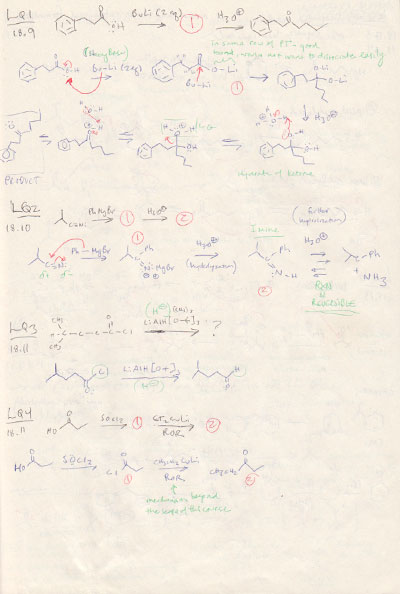
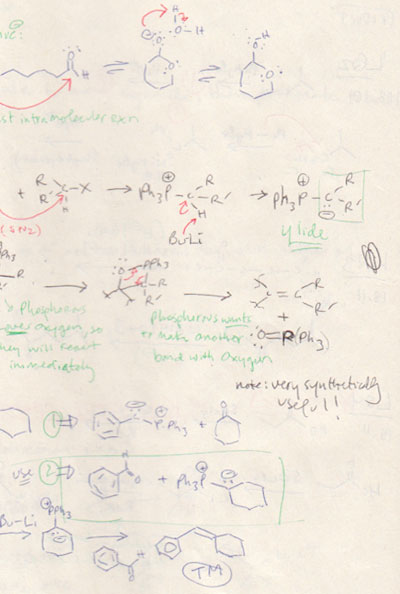
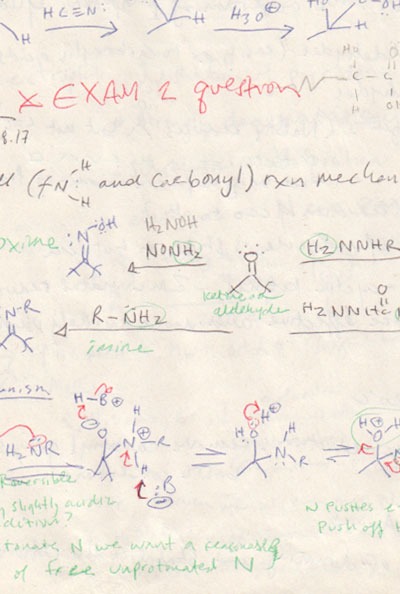
Becca Pollak has called Baltimore, Chicago, and Brooklyn her home. She has abandoned careers in photography and printmaking for the esoteric pursuit of pigment knowledge and stabilizing damaged paper and photographs. She has just completed her second year of organic chemistry, and is indescribably relieved. Currently, her favorite foods are blueberries and ice made from lemon seltzer.
